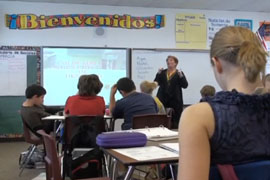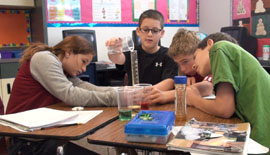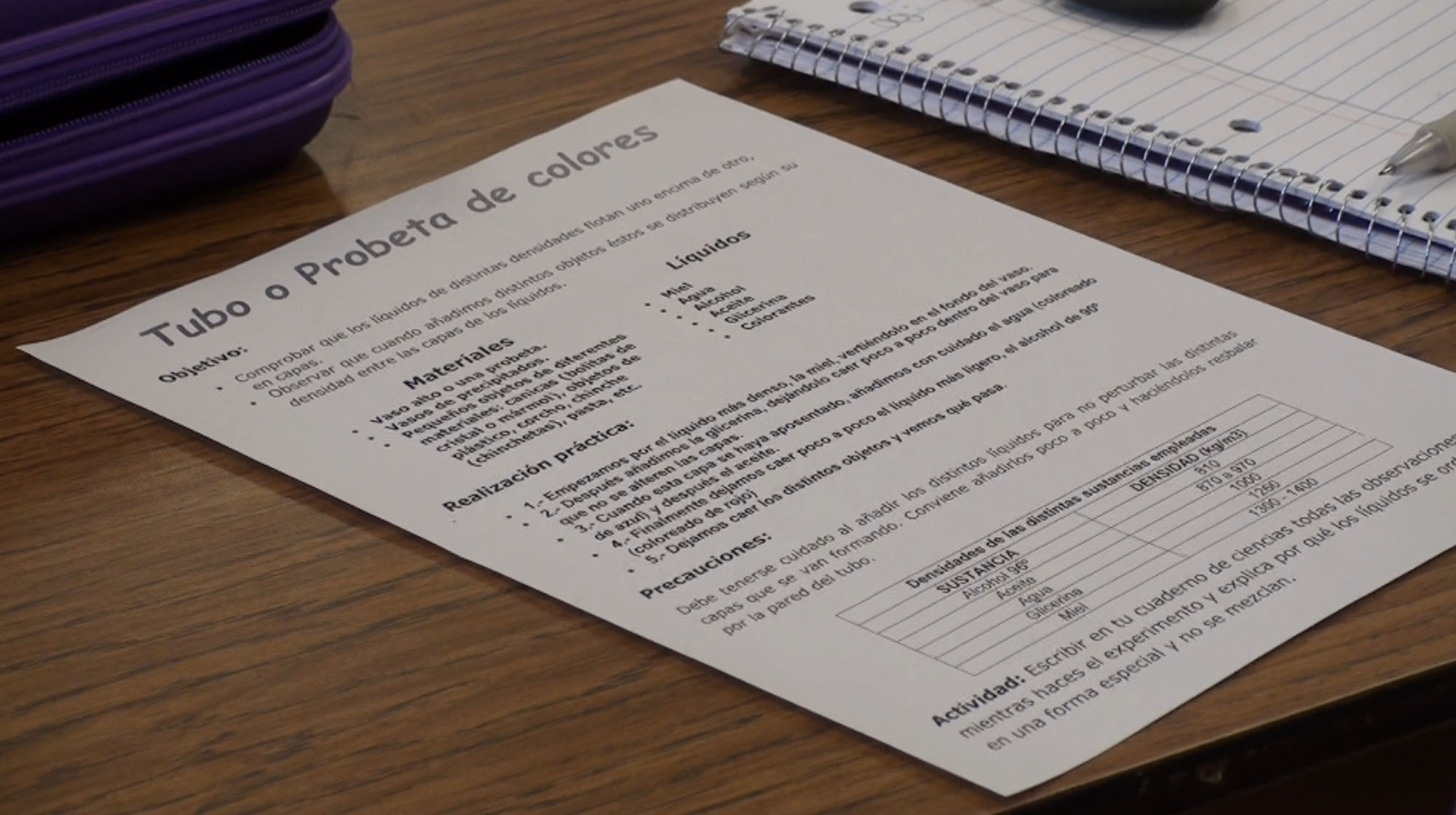Cronkite News has moved to a new home at cronkitenews.azpbs.org. Use this site to search archives from 2011 to May 2015. You can search the new site for current stories.
District says Spanish-immersion program raises test scores
CAVE CREEK – Desert Willow Elementary School teacher Luz Ordosgoitia colors water red to show her sixth-grade science class that density affects how water and several other liquids separate when mixed.
As the liquids form layers in a beaker, she asks which is the water.
“¡Rojo!” they reply in unison.
In Ordosgoitia’s class, nobody is allowed to speak English whether they’re learning about physics, chemistry or biology. It is part of a foreign language-immersion program that focuses on teaching half of the day’s subjects in Spanish to children from preschool to eighth grade.
The program, which is in its ninth year and is one of a handful in the state, enrolls about 50 new students annually.
Educators say the program has improved standardized test scores, set up students for success in high school and shown the way for others like it in Arizona.
“It has created a reputation of being high-excellence,” said Roger Hill, the school’s principal.
In preschool, students have their entire day taught in Spanish. From then on only certain subjects are taught in Spanish, ranging from math to science to social studies depending on the grade.
Sixth-grader Julian Voitek, like many kids in the program, is the only member of his family who is now bilingual.
“I like being able to speak another language outside of my home,” he said in Spanish. “It’s really fun because I know how to translate things my friends say in English.”
Jana Miller, associate superintendent of teaching and learning for Cave Creek Unified School District and founder of Desert Willow’s program, said students enrolled in the first three cohort groups met or exceeded the AIMS test scores more often than their non-immersion program counterparts in the same district from 2007-2010.
“The test score results are basically what’s selling the program,” she said.
Cristina Ladas, the district’s world languages consultant, said higher academic performance in math and reading may be due to cognitive benefits students gain from learning another language at such a young age.
The program is so successful that there aren’t enough spots for everybody interested, she said.
“We actually have to draw a lottery for families that want into the program,” Ladas said. “We do always have a waiting list.”
Jennifer Olson, who teaches science to first-graders, often uses hand motions and drawings to help with the absence of English in the classroom.
“In Spanish … they can really get their hands on things to connect the words with those real-life things,” she said.
Desert Willow Elementary School received $465,000 in grant money from the U.S. Department of Education in 2007 to expand its immersion program. It has since become a model, inspiring other communities to adopt similar teaching methods in their elementary and middle schools.
Hill, the principal, said that while some parents are resistant to having their children learn math and science in another language, majority of people in the community regard the program highly.
“I’m just glad our district has embraced learning a second language as a good thing,” he said. “It helps [students] see that there’s a whole world out there.”
Still, immersion programs are far from the norm in language education in the U.S. The majority of school districts across Arizona and the country only offer second language learning to high school students.
Nancy Rhodes, director of foreign language education at the nonprofit Center for Applied Linguistics in Washington, D.C., said foreign languages are becoming more important.
“I think now, where we are in the 21st century and we are living in a global society, we don’t have blinders on anymore,” she said. “Whether we like it or not, we have to communicate with people around the world and we have to negotiate with them.”
Immersion programs give the best results across the board for this kind of learning, she said – and Arizona is in a unique position to provide this education because it has so many native Spanish speakers.
But in Arizona, students who aren’t native English speakers and don’t demonstrate English proficiency when entering school aren’t eligible for the foreign language-immersion program, Ladas said.
Andrew LaFevre, spokesman for the Arizona Department of Education, said Superintendent of Public Instruction John Huppenthal is a proponent of foreign language learning in general but hasn’t taken a position on immersion programs because it’s up to individual school districts whether to offer them.
For students in the Cave Creek Unified School District, the program’s benefits are clear at a young age.
“I’m going to have more job opportunities in the future,” said sixth grade student Samantha Cashman, who is now a proficient Spanish speaker. “It gives you a broader expansion of [another] culture.”










